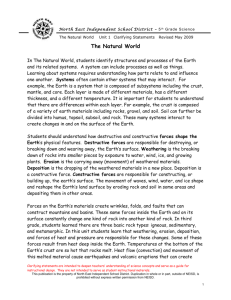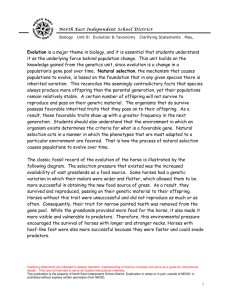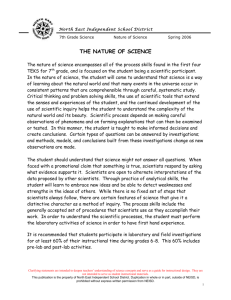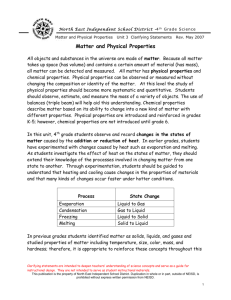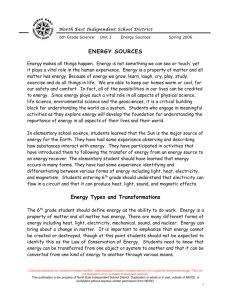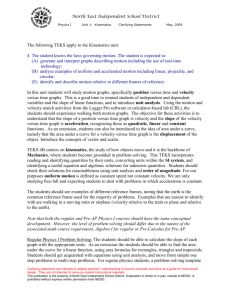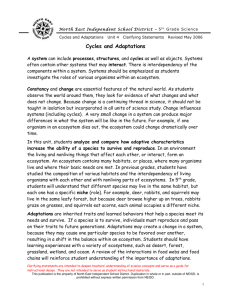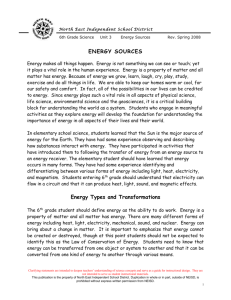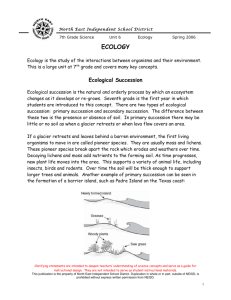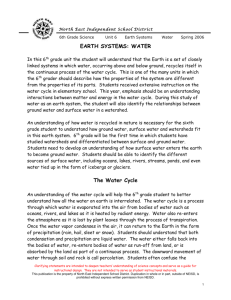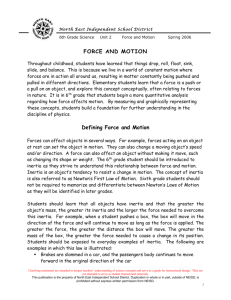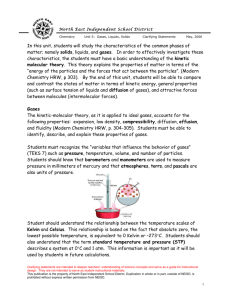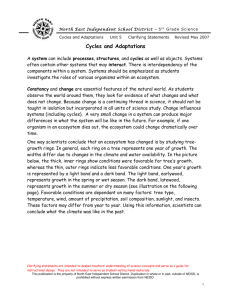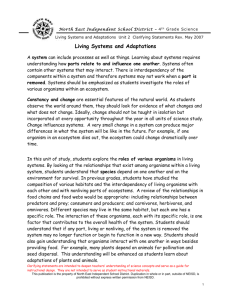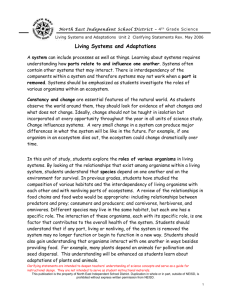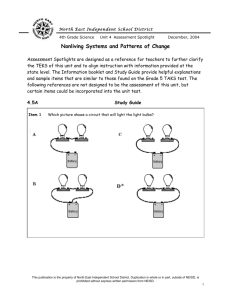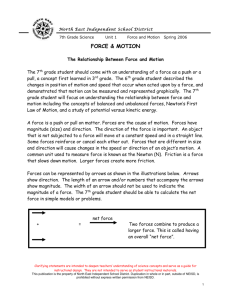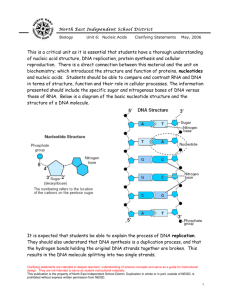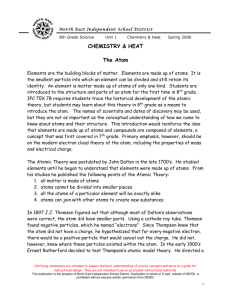Animals - North East Independent School District
advertisement
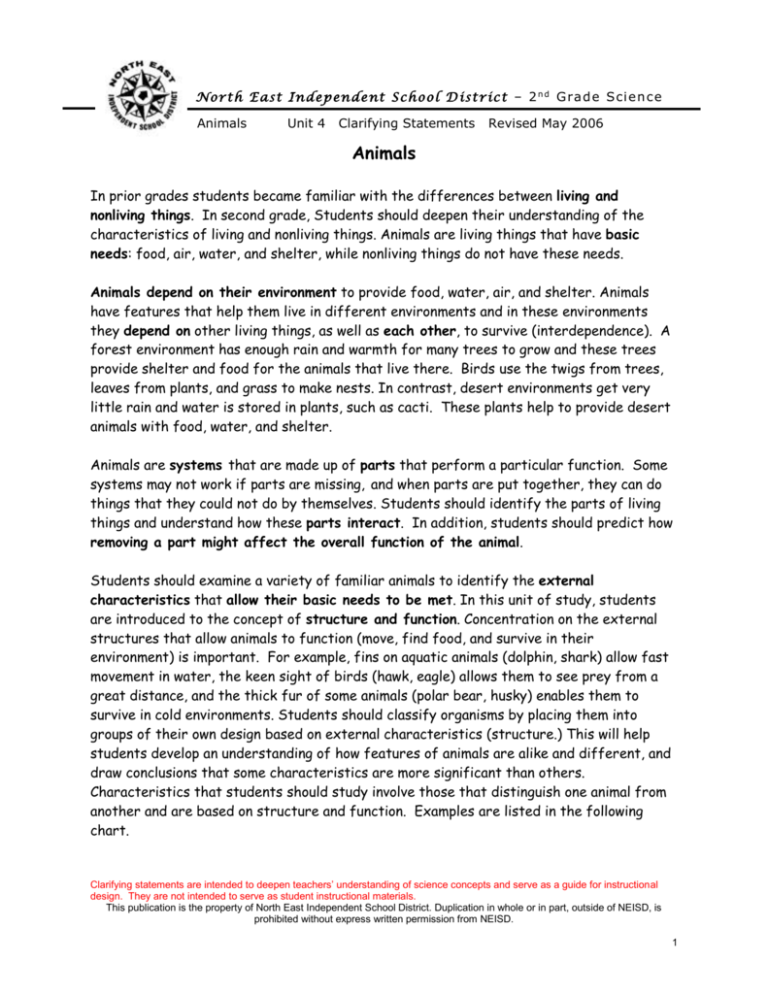
N o r t h E a st I n d ep en d e nt S c h o o l D i st ric t – 2 n d G ra d e Sci e n c e Animals Unit 4 Clarifying Statements Revised May 2006 Animals In prior grades students became familiar with the differences between living and nonliving things. In second grade, Students should deepen their understanding of the characteristics of living and nonliving things. Animals are living things that have basic needs: food, air, water, and shelter, while nonliving things do not have these needs. Animals depend on their environment to provide food, water, air, and shelter. Animals have features that help them live in different environments and in these environments they depend on other living things, as well as each other, to survive (interdependence). A forest environment has enough rain and warmth for many trees to grow and these trees provide shelter and food for the animals that live there. Birds use the twigs from trees, leaves from plants, and grass to make nests. In contrast, desert environments get very little rain and water is stored in plants, such as cacti. These plants help to provide desert animals with food, water, and shelter. Animals are systems that are made up of parts that perform a particular function. Some systems may not work if parts are missing, and when parts are put together, they can do things that they could not do by themselves. Students should identify the parts of living things and understand how these parts interact. In addition, students should predict how removing a part might affect the overall function of the animal. Students should examine a variety of familiar animals to identify the external characteristics that allow their basic needs to be met. In this unit of study, students are introduced to the concept of structure and function. Concentration on the external structures that allow animals to function (move, find food, and survive in their environment) is important. For example, fins on aquatic animals (dolphin, shark) allow fast movement in water, the keen sight of birds (hawk, eagle) allows them to see prey from a great distance, and the thick fur of some animals (polar bear, husky) enables them to survive in cold environments. Students should classify organisms by placing them into groups of their own design based on external characteristics (structure.) This will help students develop an understanding of how features of animals are alike and different, and draw conclusions that some characteristics are more significant than others. Characteristics that students should study involve those that distinguish one animal from another and are based on structure and function. Examples are listed in the following chart. Clarifying statements are intended to deepen teachers’ understanding of science concepts and serve as a guide for instructional design. They are not intended to serve as student instructional materials. This publication is the property of North East Independent School District. Duplication in whole or in part, outside of NEISD, is prohibited without express written permission from NEISD. 1 N o r t h E a st I n d ep en d e nt S c h o o l D i st ric t – 2 n d G ra d e Sci e n c e Animals Unit 4 Clarifying Statements Revised May 2006 Teacher Note: Formal classification of vertebrates and invertebrates (mammals, fish, insects, etc.) is not introduced until fourth grade. External Characteristics (Structures) Fur, hair How Needs Are Met (Functions) Provides warmth Scales, dry, rough skin Prevents the loss of moisture Regulates body temperature Helps it to breathe Retains water while on land To move and steer To breathe To protect their bodies To fly or move To get food Flexibility To climb and grasp To find food and direction Flexibility To climb and grasp Make webs Smooth, wet skin Fins Gills Feathers Wings Beaks 3 body parts 6 legs Antennae 2 body parts 8 legs Spinnerets Examples of animals Bats, dogs, people, and cows (Mammals) Lizards, snakes, turtles (Reptiles) Frogs, toads, and salamanders (Amphibians) Catfish, bass, shark (Fish) Eagles, chickens, roadrunners (Birds) Ants, beetles, butterflies (Insects) Wolf spider, tarantula, black widow (Spiders) Students should become familiar with the fact that stories sometime give plants and animals attributes that they really do not have. For example, in many children’s books the animals are depicted as speaking or showing emotions they do not possess. All living things need food to live and grow and are put into groups (producers and consumers) based on how they get energy needed to live. Plants need sunlight to grow and are called producers because they can make their own food using energy from the Sun. Animals are called consumers because they get energy from eating, or consuming, other organisms. Animals that eat only plants are called herbivores (grasshoppers, rabbits, and cows) and animals that eat only other animals are called carnivores (rattlesnakes, coyotes, and eagles). Animals that eat both plants and animals are called omnivores (humans, raccoons, and bears). Students should become aware of the basic parts of the food chain by investigating the relationship between producers and consumers. A food chain traces the path of energy as it moves from one organism to the next in an ecosystem. In ecosystems the source of energy is the Sun. The first link in a food chain, from the sun, is Clarifying statements are intended to deepen teachers’ understanding of science concepts and serve as a guide for instructional design. They are not intended to serve as student instructional materials. This publication is the property of North East Independent School District. Duplication in whole or in part, outside of NEISD, is prohibited without express written permission from NEISD. 2 N o r t h E a st I n d ep en d e nt S c h o o l D i st ric t – 2 n d G ra d e Sci e n c e Animals Unit 4 Clarifying Statements Revised May 2006 always to a plant because plants use sunlight to make food. The second link is usually to an animal that eats plants, and the third link is usually to an animal that eats other animals. The arrows in a food chain point in the direction that energy moves - they point from the organism being eaten to the organism that is doing the eating. Animals develop and change over time in different ways, such as in color, size, mass, creating sounds, and movement. Students should be encouraged to observe, record, and analyze quantities and simple measurements of things to determine how they may or may not change over time. Some changes are measurable, such as the changing mass of a caterpillar as it grows. Other changes are hard to measure, such as the growth of a butterfly inside a chrysalis. As students study animals, they should develop ideas about how animals live, grow, eat, move, and use their senses. All the changes in the life of an organism as it grows and develops are known as an animal’s life cycle. In previous grades, students have observed and recorded changes in the life cycles of organisms. In second grade, students should continue to observe organisms to understand that the life cycle is a characteristic of all living things. Students should understand that all living things come from other living things and that living things reproduce to make more of their own kind. Once formed, a new animal usually grows in a predictable way to eventually look like its parents. For example, students should recognize that fish resemble other fish, frogs resemble other frogs, and that frogs are different from fish. Note: Many campuses use the Constancy and Change Vistas, which contain lessons on either lifecycles or adaptations. The Vistas suggest the following organisms (focus is indicated in parenthesis): Kindergarten – Ladybugs (life cycle) 3rd Grade – Frogs (adaptations) 1st Grade – Mealworms (life cycle) 4th Grade – Bats (adaptations) 2nd Grade – Butterflies (life cycle) 5th Grade – Brown Pelican (adaptations) Dissections are not recommended for elementary students. Clarifying statements are intended to deepen teachers’ understanding of science concepts and serve as a guide for instructional design. They are not intended to serve as student instructional materials. This publication is the property of North East Independent School District. Duplication in whole or in part, outside of NEISD, is prohibited without express written permission from NEISD. 3
